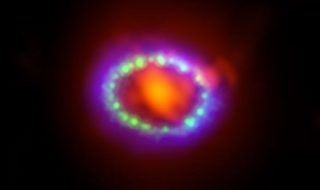Radiation from two ancient supernovae that exploded millions of years ago might have contributed to Earth mass extinction.

Back in April, a team of researchers used core samples from the Atlantic, Indian and Pacific Oceans to suggest that two ancient supernovae led to the distribution of radiation around the world in the form of iron-60 radionuclides. Although the effects of these explosions on the Earth’s climate and organisms were not known at the time, a new study suggests that they likely exposed the Earth’s biology and atmosphere to long-lasting cosmic radiation.
“I was surprised to see as much effect as there was,” said Adrian Melott, a physics professor from the University of Kansas and co-author of the new paper set to be published in Astrophysical Journal Letters. “I was expecting there to be very little effect at all. The supernovae were pretty far way – more than 300 light years – that’s really not very close.”
Melott claims that the two stars behind the supernovae exploded 1.7 to 3.2 and 6.5 to 8.7 million years ago approximately 300 light years from the Earth. In addition to disrupting animals’ sleep patterns for a few weeks, the data suggests that the events exposed every creature on the surface of the Earth and the shallow regions of its oceans to radiation that was equivalent to one computed tomography (CT) scan per year.
“The big thing turns out to be the cosmic rays,” Melott said. “The really high-energy ones are pretty rare. They get increased by quite a lot here—for a few hundred to thousands of years, by a factor of a few hundred. The high-energy cosmic rays are the ones that can penetrate the atmosphere. They tear up molecules, they can rip electrons off atoms, and that goes on right down to the ground level. Normally that happens only at high altitude.”
The team suggests that the increased radiation would have been enough to affect the terrestrial atmosphere and biota, including an increase in the mutation rate and frequency of cancer.
Most interestingly, a minor mass extinction took place on the Earth approximately 2.59 million years ago. Melott and his team claim that it is possible that these ancient supernovae could have been connected to this extinction event through an increase in cosmic rays. Such an increase could alter the lowest layer of the Earth’s atmosphere – the troposphere – and lead to significant climate changes.
“There was climate change around this time,” Melott said. “Africa dried out, and a lot of the forest turned into savannah. Around this time and afterwards, we started having glaciations – ice ages – over and over again, and it’s not clear why that started to happen. It’s controversial, but maybe cosmic rays had something to do with it.”
Although the findings have yet to be published officially, they can be read at the pre-print site arXiv.org here.


